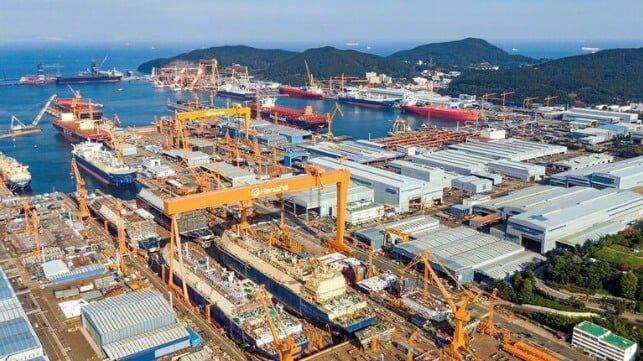In the first half of 2025, South Korea’s shipbuilding industry saw a strong rebound in orders, especially in the container ship sector. The Korea Development Bank’s Overseas Economic Research Institute released a report on July 29 stating that the growth in South Korean orders was mainly due to the United States’ plan to impose port fees on Chinese shipbuilding starting in October.

The report points out that in the first half of this year, against the backdrop of an overall slowdown in the global new shipbuilding market, South Korean shipbuilding companies saw an overall increase in order volume, with their market share rising from 17.2% to 25.1% compared to the same period in 2024. This growth is particularly important for the South Korean shipbuilding industry because in 2024, South Korean shipbuilding orders had fallen to an eight-year low, accounting for only 15% of the total global new shipbuilding orders for the year.
Globally, new ship orders in 2025 have declined compared to previous years, and with economic and trade concerns intensifying, order volumes have fallen further. According to Clarkson data, based on compensated gross tonnage (CGT), the total volume of new ship orders worldwide from January to June this year was 19.38 million CGTs (647 vessels), a sharp decline of 54% compared to the same period last year (42.58 million CGTs, 1,788 vessels).
While most sectors saw weak ordering, orders for liquefied natural gas (LNG) carriers plummeted particularly sharply, falling 83% to just 1 million CGT. This was due to the completion of QatarEnergy’s historic LNG fleet expansion project and the fact that other countries are taking a wait-and-see approach following a surge in demand in the sector.
In addition, the Office of the United States Trade Representative (USTR) has indicated that it will require certain LNG exports to use US-flagged vessels, which will also have a significant impact on the newbuilding market for LNG carriers.
Among all major sectors, only container ships have not seen a slowdown in orders. In recent years, Chinese shipyards have dominated the container ship market thanks to their various advantages. However, with ship designs becoming increasingly complex and shifting toward alternative fuels, as well as the USTR’s port fee policy targeting China, South Korean shipyards have regained market share in this sector.
With US tariffs looming, South Korea reported that container ship orders accounted for 50% of its total orderbook through 2025, totaling 4.87 million CGTs. As of July 24, HD Korea Shipbuilding & Offshore Engineering (HD KSOE), a subsidiary of HD Hyundai, had secured orders for 50 container ship this year.
In contrast, only two container ship orders were placed at Korean shipyards in the first half of 2024.
Due to various factors, although the order volume of China’s shipbuilding industry has declined compared to previous years, according to Clarkson data, as of the end of June, Chinese shipbuilders had 96.82 million CGTs of orders on hand, an increase of 20.44 million CGTs over the same period last year, with a market share of 59%, still ranking first in the market.
According to data from the China Shipbuilding Industry Association, from January to June 2025, China’s shipbuilding completion volume was 24.13 million deadweight tons, down 3.5% year-on-year; new orders were 44.33 million deadweight tons, down 18.2% year-on-year; and as of the end of June, the order backlog was 234.54 million deadweight tons, up 36.7% year-on-year.
Despite the relative decline, China’s shipbuilding industry remains strong. From January to June 2025, China’s three major shipbuilding indicators accounted for 51.7%, 68.3%, and 64.9% of the world’s total in terms of deadweight tonnage, and 47.2%, 64.0%, and 57.6% in terms of compensated gross tonnage, respectively, maintaining its global lead.


